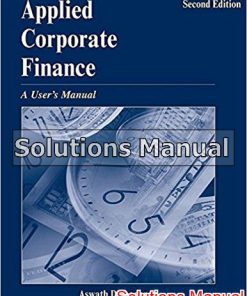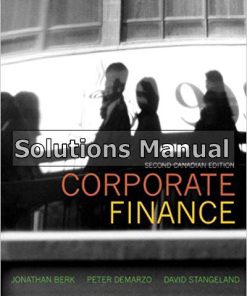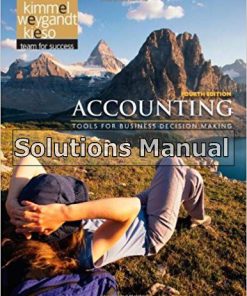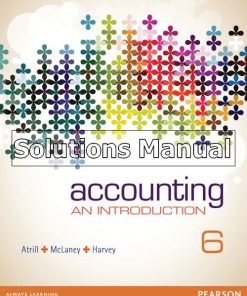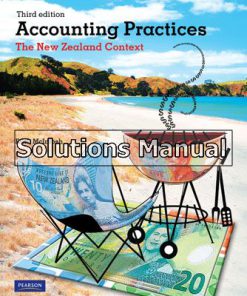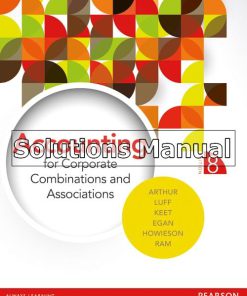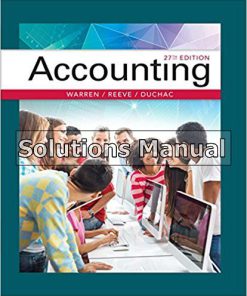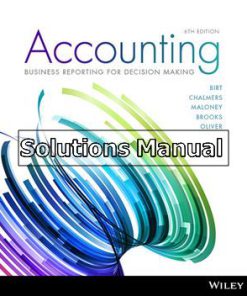Corporate Finance European Edition 2nd Edition Hillier Solutions Manual
$26.50$50.00 (-47%)
Corporate Finance European Edition 2nd Edition Hillier Solutions Manual.
You may also like
Corporate Finance European Edition 2nd Edition Hillier Solutions Manual

Product details:
- ISBN-10 : 0077139143
- ISBN-13 : 978-0077139148
- Author: Ross, Westerfield, Jaffe and Jordan
An adaptation of the hugely successful Corporate Finance text by Ross, Westerfield, Jaffe and Jordan aimed specifically at courses outside the United States. Covering the core and emerging topics in an engaging and effective way makes this text a must have for all students studying corporate finance.
Table contents:
- Part 1: Overview
- 1 Introduction to Corporate Finance
- 1.1 What is Corporate Finance?
- 1.2 The Goal of Financial Management
- 1.3 Financial Markets
- 1.4 Corporate Finance in Action: The Case of Alphabet
- Summary and Conclusions
- Questions and Problems
- Exam Question (45 minutes)
- Practical Case Study
- References
- Additional Reading
- Endnote
- 2 Corporate Governance
- 2.1 The Corporate Firm
- 2.2 The Agency Problem and Control of the Corporation
- 2.3 The Governance Structure of Corporations
- 2.4 Corporate Governance Principles
- 2.5 International Corporate Governance
- 2.6 Corporate Governance in Action: Starbucks
- Summary and Conclusions
- Questions and Problems
- Exam Question (45 minutes)
- Mini Case
- Practical Case Study
- Reference
- Additional Reading
- 1 Introduction to Corporate Finance
- Part 2: Value and Capital Budgeting
- 3 Financial Statement Analysis
- 3.1 The Statement of Financial Position
- 3.2 The Income Statement
- 3.3 Taxes
- 3.4 Net Working Capital
- 3.5 Cash Flow
- 3.6 Financial Statement Analysis
- 3.7 Ratio Analysis
- 3.8 The Du Pont Identity
- 3.9 Using Financial Statement Information
- Summary and Conclusions
- Questions and Problems
- Exam Question (45 minutes)
- Mini Case
- Practical Case Study
- Relevant Accounting Standards
- Additional Reading
- 4 Discounted Cash Flow Valuation
- 4.1 Valuation: The One-period Case
- 4.2 Valuation: The Multi-period Case
- 4.3 Compounding Periods
- 4.4 Simplifications
- Summary and Conclusions
- Questions and Problems
- Exam Question (45 minutes)
- Mini Case
- Practical Case Study
- Additional Reading
- Endnotes
- 5 How to Value Bonds and Stocks
- 5.1 Definition and Example of a Bond
- 5.2 How to Value Bonds
- 5.3 Bond Concepts
- 5.4 The Present Value of Equity
- 5.5 Estimates of Parameters in the Dividend Growth Model
- 5.6 Growth Opportunities
- 5.7 The Dividend Growth Model and the NPVGO Model
- 5.8 Stock Market Reporting
- 5.9 Firm Valuation
- Summary and Conclusions
- Questions and Problems
- Exam Question (45 minutes)
- Mini Case
- Practical Case Study
- Relevant Accounting Standards
- Additional Reading
- Endnotes
- 6 Net Present Value and Other Investment Rules
- 6.1 The Net Present Value Method
- 6.2 The Payback Period Method
- 6.3 The Discounted Payback Period Method
- 6.4 The Average Accounting Return Method
- 6.5 The Internal Rate of Return
- 6.6 Problems with the IRR Approach
- 6.7 The Profitability Index
- 6.8 Other Investment Appraisal Methods
- 6.9 The Practice of Capital Budgeting
- Summary and Conclusions
- Questions and Problems
- Exam Question (45 minutes)
- Mini Case
- Practical Case Study
- Additional Reading
- Endnotes
- 7 Making Capital Investment Decisions
- 7.1 Incremental Cash Flows
- 7.2 Energy Renewables Ltd: An Example
- 7.3 Inflation and Capital Budgeting
- 7.4 Alternative Definitions of Operating Cash Flow
- 7.5 Investments of Unequal Lives: The Equivalent Annual Cost Method
- Summary and Conclusions
- Questions and Problems
- Exam Question (45 minutes)
- Mini Case
- Practical Case Study
- Relevant Accounting Standards
- Additional Reading
- Endnote
- 8 Risk Analysis, Real Options and Capital Budgeting
- 8.1 Sensitivity Analysis, Scenario Analysis and Break-even Analysis
- 8.2 Monte Carlo Simulation
- 8.3 Real Options
- 8.4 Decision Trees
- Summary and Conclusions
- Questions and Problems
- Exam Question (45 minutes)
- Mini Case
- Practical Case Study
- Relevant Accounting Standards
- Additional Reading
- Endnotes
- 3 Financial Statement Analysis
- Part 3: Risk
- 9 Risk and Return: Lessons from Market History
- 9.1 Returns
- 9.2 Holding Period Returns
- 9.3 Return Statistics
- 9.4 Average Stock Returns and Risk-free Returns
- 9.5 Risk Statistics
- 9.6 More on Average Returns
- Summary and Conclusions
- Questions and Problems
- Exam Question (45 minutes)
- Mini Case
- Practical Case Study
- Relevant Accounting Standards
- References
- Additional Reading
- Endnote
- 10 Risk and Return: The Capital Asset Pricing Model
- 10.1 Individual Securities
- 10.2 Expected Return, Variance and Covariance
- 10.3 The Return and Risk for Portfolios
- 10.4 The Efficient Set for Two Assets
- 10.5 The Efficient Set for Many Securities
- 10.6 Diversification: An Example
- 10.7 Riskless Borrowing and Lending
- 10.8 Market Equilibrium
- 10.9 The Capital Asset Pricing Model
- 10.10 Criticisms of the CAPM
- 10.11 Variations of the CAPM
- Summary and Conclusions
- Questions and Problems
- Exam Question (45 minutes)
- Mini Case
- Practical Case Study
- References
- Additional Reading
- Endnotes
- 11 Factor Models, the Arbitrage Pricing Theory, and Other Alternatives to CAPM
- 11.1 Factor Models: Announcements, Surprises and Expected Returns
- 11.2 Risk: Systematic and Unsystematic
- 11.3 Systematic Risk and Betas
- 11.4 Portfolios and Factor Models
- 11.5 Betas and Expected Returns
- 11.6 The Capital Asset Pricing Model and the Arbitrage Pricing Theory
- 11.7 Other Alternatives to CAPM
- Summary and Conclusions
- Questions and Problems
- Exam Question (45 minutes)
- Mini Case
- References
- Additional Reading
- Endnotes
- 12 Risk, Cost of Capital and Capital Budgeting
- 12.1 The Cost of Equity Capital
- 12.2 Estimation of Beta
- 12.3 Determinants of Beta
- 12.4 Extensions of the Basic Model
- 12.5 Estimating Carrefour Group’s Cost of Capital
- 12.6 Reducing the Cost of Capital
- 12.7 How Do Corporations Estimate Cost of Capital in Practice?
- 12.8 Economic Value Added and the Measurement of Financial Performance
- Summary and Conclusions
- Questions and Problems
- Exam Question (45 minutes)
- Mini Case
- References
- Additional Reading
- Endnotes
- 13 Efficient Capital Markets and Behavioural Finance
- 13.1 Can Financing Decisions Create Value?
- 13.2 A Description of Efficient Capital Markets
- 13.3 The Different Types of Efficiency
- 13.4 The Evidence
- 13.5 The Behavioural Challenge to Market Efficiency
- 13.6 Empirical Challenges to Market Efficiency
- 13.7 Behavioural Biases in Corporate Finance
- Summary and Conclusions
- Questions and Problems
- Exam Question (45 minutes)
- Mini Case
- Practical Case Study
- Relevant Accounting Standards
- References
- Additional Reading
- Endnotes
- 9 Risk and Return: Lessons from Market History
- Part 4: Long-term Financing
- 14 Long-term Financing: An Introduction
- 14.1 Ordinary Shares: The Basics
- 14.2 Corporate Long-term Debt: The Basics
- 14.3 Preference Shares
- 14.4 Patterns of Financing
- 14.5 Hierarchies in Long-term Financing
- Summary and Conclusions
- Questions and Problems
- Exam Question (45 minutes)
- Mini Case
- Practical Case Study
- Relevant Accounting Standard
- References
- Additional Reading
- Endnote
- 15 Equity Financing
- 15.1 The Public Issue
- 15.2 Alternative Issue Methods
- 15.3 The Cash Offer
- 15.4 The Announcement of New Equity and the Value of the Firm
- 15.5 The Cost of New Issues
- 15.6 Rights
- 15.7 Shelf Registration
- 15.8 The Private Equity Market
- Summary and Conclusions
- Questions and Problems
- Exam Question (45 minutes)
- Mini Case
- Practical Case Study
- Relevant Accounting Standard
- References
- Additional Reading
- Endnotes
- 16 Debt Financing
- 16.1 Bank Loans
- 16.2 Debt Financing
- 16.3 The Public Issue of Bonds
- 16.4 Bond Refunding
- 16.5 Bond Ratings
- 16.6 Some Different Types of Bonds
- 16.7 Private Placement Compared to Public Issues
- 16.8 Long-term Syndicated Bank Loans
- Summary and Conclusions
- Questions and Problems
- Exam Question (45 minutes)
- Mini Case
- Practical Case Study
- Relevant Accounting Standards
- References
- Additional Reading
- Endnotes
- 17 Leasing
- 17.1 Types of Lease Financing
- 17.2 Accounting and Leasing
- 17.3 The Cash Flows of Leasing
- 17.4 A Detour for Discounting and Debt Capacity with Corporate Taxes
- 17.5 NPV Analysis of the Lease-versus-buy Decision
- 17.6 Does Leasing Ever Pay?
- 17.7 Reasons for Leasing
- 17.8 Some Unanswered Questions about Leasing
- Summary and Conclusions
- Questions and Problems
- Exam Question (45 minutes)
- Mini Case
- Practical Case Study
- Relevant Accounting Standards
- References
- Additional Reading
- Endnotes
- 14 Long-term Financing: An Introduction
- Part 5: Capital Structure and Dividend Policy
- 18 Capital Structure: Basic Concepts
- 18.1 The Capital Structure Question and the Pie Theory
- 18.2 Maximizing Firm Value versus Maximizing Shareholder Interests
- 18.3 Financial Leverage and Firm Value: An Example
- 18.4 Modigliani and Miller: Proposition II (No Taxes)
- 18.5 Corporate Taxes
- 18.6 Personal Taxes
- Summary and Conclusions
- Questions and Problems
- Exam Question (45 minutes)
- Mini Case
- Practical Case Study
- References
- Additional Reading
- Endnotes
- 19 Capital Structure: Limits to the Use of Debt
- 19.1 Costs of Financial Distress
- 19.2 Description of Financial Distress Costs
- 19.3 Can Costs of Debt Be Reduced?
- 19.4 Integration of Tax Effects and Financial Distress Costs
- 19.5 Signalling
- 19.6 Shirking, Perquisites and Bad Investments: A Note on Agency Cost of Equity
- 19.7 The Pecking Order Theory
- 19.8 Growth and the Debt–equity Ratio
- 19.9 Market Timing Theory
- 19.10 How Firms Establish Capital Structure
- Summary and Conclusions
- Questions and Problems
- Exam Question (45 minutes)
- Mini Case
- Practical Case Study
- References
- Additional Reading
- Endnotes
- 20 Valuation and Capital Budgeting for the Levered Firm
- 20.1 Adjusted Present Value Approach
- 20.2 Flow to Equity Approach
- 20.3 Weighted Average Cost of Capital Method
- 20.4 A Comparison of the APV, FTE and WACC Approaches
- 20.5 Capital Budgeting When the Discount Rate Must Be Estimated
- 20.6 APV Example
- 20.7 Beta and Leverage
- 20.8 Net Asset Value
- Summary and Conclusions
- Questions and Problems
- Exam Question (45 minutes)
- Mini Case
- Practical Case Study
- References
- Additional Reading
- Endnotes
- 21 Dividends and Other Payouts
- 21.1 Different Types of Dividends
- 21.2 Standard Method of Cash Dividend Payment
- 21.3 The Benchmark Case: An Illustration of the Irrelevance of Dividend Policy
- 21.4 Share Repurchases
- 21.5 Personal Taxes and Dividends
- 21.6 Real-world Factors Favouring a High-dividend Policy
- 21.7 The Clientele Effect
- 21.8 A Catering Theory of Dividends
- 21.9 What We Know and Do Not Know about Dividend Policy
- 21.10 Stock Dividends and Stock Splits
- Summary and Conclusions
- Questions and Problems
- Exam Question (45 minutes)
- Mini Case
- Practical Case Study
- Relevant Accounting Standards
- References
- Additional Reading
- Endnotes
- 18 Capital Structure: Basic Concepts
People also search:
corporate finance 13th edition ross
corporate finance ehrhardt
|
corporate finance fourth edition
|
journal of corporate finance editorial board
journal of corporate finance special issue



